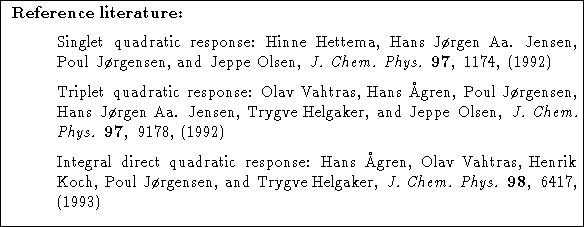

An example of a quadratic response function
is the first
hyperpolarizability . If we are
interested in the
![]() component only we may use the following input:
component only we may use the following input:
**DALTON INPUT .RUN RESPONSE **WAVE FUNCTIONS .HF **RESPONSE *QUADRATIC .DIPLNZ *END OF INPUTWhen no frequencies are given in the input, the static value is assumed by default. If we wish to calculate dynamic hyperpolarizabilities we supply frequencies , but in this case we have two frequencies
 ).
).
The residue of a quadratic response function gives two-photon
transition amplitudes . For such a
calculation we supply the same extra
keywords as in the linear case (Sec.  ):
):
**RESPONSE *QUADRATIC .DIPLNZ .SINGLE RESIDUE .ROOTS 2 0 0 0 *END OF INPUTwhich in this case means the two-photon transition amplitude between the reference state and the first two excited states in the first symmetry. In general the residue of a quadratic response function corresponds to the induced transition moment of an operator A due to a perturbation B. The C operator is arbitrary and is not specified. A typical example is the dipole matrix element between a singlet and triplet state that is induced by spin-orbit coupling (phosphorescence) . For this special case we have the keyword, .PHOSPHORESCENCE under *QUADRATIC, which sets A to electric dipole operators and B to spin-orbit operators.
It is possible to construct double residues of the quadratic response function, the interpretation of which is transition moments between two excited states. Specifying .DOUBLE in the example above thus gives the matrix elements of the z-component of the dipole moment between all excited specified in .ROOTS. Note that the diagonal contributions gives, not the expectation value in the excited state, but rather the difference relative to the reference state expectation value.